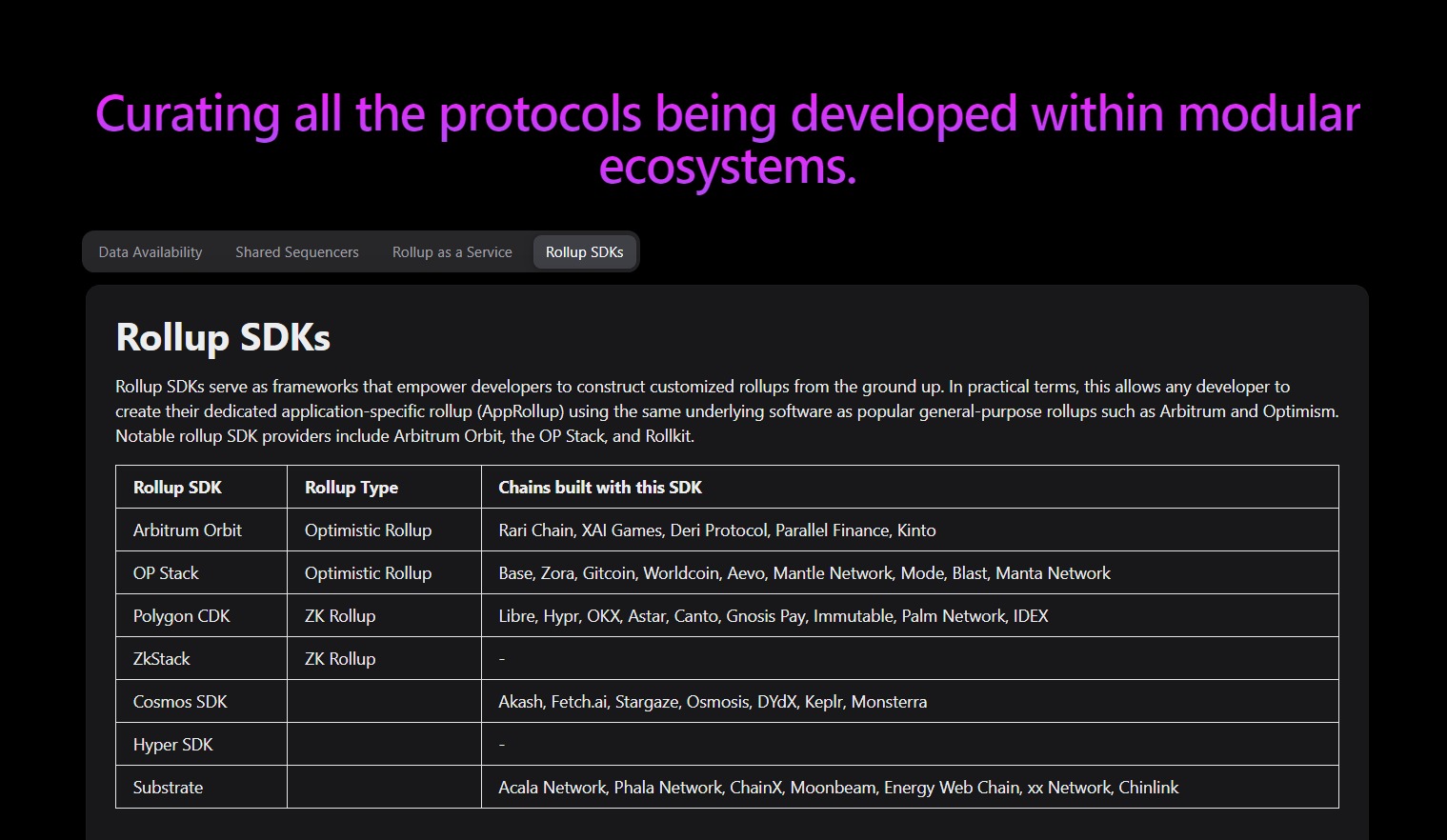It’s hard to keep track of all the projects launching in modularity space! Here is a solution.
 chandan
chandanTable of contents
- DA (Data Availability) Space:
- Shared Sequencers: Powering the Future of Rollups ⚡️
- Rollup-as-a-Service
- Rollups SDks
- 1. Arbitrum Orbit
- Key Features of Arbitrum Nitro
- 2. OP Stack by Optimism
- Key Features of OP stack
- 3. Polygon CDK
- Key Features of Polygon CDK
- 4. zk Stack by zkSync
- Key Features of zkStack
- 5. Cosmos SDK
- Advantages of Cosmos SDK
- 6. Hyper SDK by Avalanche
- Key Features and Benefits
- 7. Substrate by Polkadot
- Key Features of Substrate
- Want to contribute? We welcome your feedback!

Innovation overload in the modularity space! It’s hard to keep track of all the awesome projects launching.
That’s why I’m curating them all at Modular (modular-sigma.vercel.app)
Here’s a sneak peek of some projects:
DA (Data Availability) Space:
Data availability refers to guarantees that the data needed to verify a block in the blockchain is actually available to all network participants. This concept is fundamental to the proper functioning of blockchains, as it allows for full validation of the blockchain’s history and current state by any participant, thereby maintaining the decentralized and trustless nature of the network. Without guaranteed data availability, participants could not independently verify the legitimacy of transactions and blocks, which could lead to issues like fraud or censorship within the network.
EigenDA (by EigenLabs): First mover! This Ethereum-based service guarantees data availability using EigenLayer’s restaking system.
EIP-4844 blobs : A new Ethereum feature allowing temporary storage of data chunks (blobs) on beacon nodes.
Celestia 🪶: Makes light nodes lighter! Utilizes data availability sampling (DAS) so nodes don’t download entire blocks, and namespaced Merkle trees (NMTs) for targeted data retrieval by execution and settlement layers.
Avail DA ✅: Enables developers to verify data availability themselves using validity proofs, eliminating trust reliance on Avail.
NEAR | Data Availability : NEAR Protocol’s solution for scalable Web3, specifically designed to address challenges faced by Ethereum rollups.
Shared Sequencers: Powering the Future of Rollups ⚡️
The goal of shared sequencing is to bring stronger network security and better network decentralization through shared usage of sequencers as roll-ups currently maintain their own sets of sequencers (usually only one sequencer) and aren’t censorship-resistant and interoperable with other rollups. (Similar to problems plaguing layer-1 networks)
Espresso Systems ☕️: Their Espresso Sequencer focuses on credible neutrality, smooth interoperability, and aligning rollup economics with the underlying Layer 1 blockchain.
Astria : A permissionless network where anyone can join the sequencer pool, ensuring a truly decentralized system.
Radius ️: Combats MEV (malicious actors manipulating transaction order) using advanced cryptography, keeping things fair and efficient.
Rollup-as-a-Service
Developers building dApps have several options for deployment, including existing blockchains, Layer 2 solutions (L2), custom appchains, and rollups. Rollups can offer a sweet spot between customization, performance, and development effort, particularly with the simplified setup offered by Rollups-as-a-Service (RaaS) providers. These providers offer tools and services, ranging from rollup management to no-code deployment, enabling easy creation and maintenance of custom rollups.
Conduit ️: Offers a robust suite of tools for deploying both optimistic and zk-rollups, catering to a wider range of developer needs.
AltLayer : Focuses on user experience with their innovative “Flash” technology, enabling instant finality for rollup transactions.
Dymension : Acts as a settlement layer and bridging hub, connecting your rollup to various blockchains for seamless asset transfers.
Cartesi : Provides a unique “Linux on Blockchain” environment, allowing developers to leverage familiar tools like Linux and tools like the Ethereum Virtual Machine (EVM) for rollup development.
Caldera : Specializes in launching optimistic rollups, known for their fast transaction speeds and familiar programming environment.
Rollups SDks
1. Arbitrum Orbit
Arbitrum Orbit is designed to facilitate modifications to the Arbitrum Nitro codebase. It features a perpetual and recursive license, enabling the creation of Orbit chains capable of hosting other chains under the same license conditions. Orbit chains can settle on various Arbitrum networks but are not tailored for post-deployment network switching. The platform supports both AnyTrust and Rollup chain types, accommodating diverse security and cost requirements.
Key Features of Arbitrum Nitro
Optimistic Rollups: At its core, Arbitrum operates as an optimistic rollup, ensuring the recording of all transactions on the Ethereum chain for integrity and security.
WAVM for Fraud Proofs: Nitro introduces the WebAssembly Virtual Machine (WAVM) for executing fraud proofs, a modified version of Wasm designed for the blockchain environment, enhancing security and reliability.
Advanced Calldata Compression: Nitro employs battle-tested compression algorithms, significantly reducing the cost of posting transaction data on Ethereum, contributing to overall lower transaction fees.
2. OP Stack by Optimism
OP Stack comprises software components forming the infrastructure of the Optimism mainnet. Operating on the Bedrock iteration, OP Stack facilitates the launch of optimistic Rollup networks and supports the proposed Optimism Superchain, an interconnected network of layer 2s. Its architecture includes the Ethereum Virtual Machine (EVM) for the execution layer, a single sequencer module for transaction processing, and various layers for data formatting, settlement, and governance.
Key Features of OP stack
The Superchain: The Superchain is a future development by Optimism, envisioned as a network of Layer 2 chains (OP Chains) built on the OP Stack. The OP Chains will share security, a communication layer, and a technology stack, but will be standardized and interchangeable, differing from traditional multi-chain designs.
Ethereum Equivalence: Bedrock aims for high compatibility with Ethereum, offering developers a familiar experience by allowing the running of smart contracts and dApps designed for Ethereum without modification and utilizing existing Ethereum tooling and infrastructure.
3. Polygon CDK
Polygon CDK is an open-source and modular codebase designed to simplify the intricate process of constructing and launching ZK-powered Layer 2 (L2) chains for Ethereum. Leveraging zero-knowledge proofs ensures cryptographic security and near-instant finality for transactions.
Key Features of Polygon CDK
Unified Liquidity: Polygon CDK fosters fluid asset transfers across the ecosystem, enhancing the digital economy of both Polygon and Ethereum.
Robust Data Availability: A dedicated Data Availability Committee (DAC) ensures off-chain data remains accessible and secure, maintaining the integrity and resilience of the blockchain.
Composable Interoperability: The innovative LXLY bridge underscores Polygon CDK’s commitment to seamless interaction among diverse blockchains, fostering a unified and versatile ecosystem.
4. zk Stack by zkSync
ZK Stack is a modular, open-source framework. It is specifically designed to build custom ZK-powered Layer 2 (L2) and Layer 3 (L3) Hyperchains. The framework is based on the code of zkSync Era.
Key Features of zkStack
Trustless Network Connectivity: Hyperchains built with ZK Stack seamlessly connect in a trustless network. This connectivity ensures low latency and shared liquidity, enhancing interoperability.
Versatility Across Use Cases: ZK Stack caters to various use cases, including gaming, social networks, and enterprise applications. It offers tailored solutions to meet specific needs within diverse application scenarios.
Asynchronous Connectivity Option: ZK Stack provides an asynchronous connectivity option. This feature positions ZK Stack as a tool for building secure, customizable, and interoperable decentralized blockchains.
5. Cosmos SDK
The Cosmos SDK is an open-source framework for multi-asset PoS and permissioned PoA blockchains, known for modularity and supporting application-specific blockchains with tools for enhanced interoperability and scalability.
Advantages of Cosmos SDK
Customizability and Flexibility: The Cosmos SDK provides a highly customizable and flexible framework, enabling developers to create bespoke blockchain solutions tailored to specific use cases, with ongoing modularity improvements.
Inter-Blockchain Communication (IBC): A cornerstone of the Cosmos ecosystem, IBC streamlines communication and transactions between different protocols, enhancing interoperability without the need for token wrapping.
Developer-Friendly Environment: With Go support, the Cosmos SDK is accessible to a broad range of developers, fostering a collaborative and secure environment for building decentralized platforms.
6. Hyper SDK by Avalanche
HyperSDK, developed by Ava Labs, is an opinionated framework that expedites the creation of high-performance blockchains in the Avalanche ecosystem, simplifying custom VM development for fast, scalable, and efficient blockchain solutions.
Key Features and Benefits
High-Performance Virtual Machines: HyperSDK provides a robust foundation for quickly constructing high-performance VMs.
Simplified Development Process: By abstracting away runtime complexities, HyperSDK allows developers to focus on customization and innovation.
Versatile HyperChains: HyperSDK-produced HyperChains are adaptable, serving various functions from NFT marketplaces to DeFi protocols.
7. Substrate by Polkadot
Substrate, an open-source SDK using Rust, enables the creation of application-specific blockchains. These can operate independently or collaboratively with other Polkadot chains, benefiting from shared security and interoperability features.
Key Features of Substrate
Modularity and Flexibility: Substrate’s modular architecture allows developers to create tailored blockchains for various applications, from DeFi to gaming, by selecting and combining components like consensus mechanisms and governance models.
Seamless Upgrades: Substrate’s unique upgrade mechanism allows for blockchain network upgrades without hard forks, ensuring uninterrupted service.
Interoperability: Substrate supports the Polkadot ecosystem, facilitating communication and asset exchange between Substrate-based blockchains and other Polkadot networks, enabling diverse cross-chain applications and services.
Want to contribute? We welcome your feedback!
Report issues and suggest improvements directly on GitHub: Modular
Reach out to me chandan
Subscribe to my newsletter
Read articles from chandan directly inside your inbox. Subscribe to the newsletter, and don't miss out.
Written by
